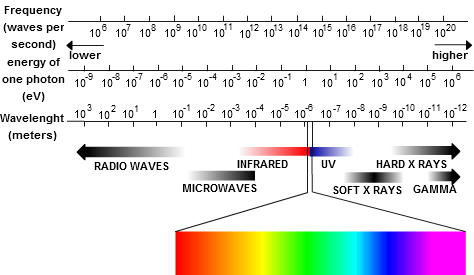Nature of Penetrating Radiation

The Electromagnetic Spectrum
X-rays and gamma rays differ only in their source of origin. X-rays are produced by an x-ray generator and gamma radiation is the product of radioactive atoms. They are both part of the electromagnetic spectrum. They are waveforms, as are light rays, microwaves, and radio waves. X-rays and gamma rays cannot been seen, felt, or heard. They possess no charge and no mass and, therefore, are not influenced by electrical and magnetic fields and will generally travel in straight lines. However, they can be diffracted (bent) in a manner similar to light.
Both X-rays and gamma rays can be characterized by frequency, wavelength, and velocity. However, they act somewhat like a particle at times in that they occur as small "packets" of energy and are referred to as "photons." Electromagnetic radiation has also been described in terms of a stream of photons (massless particles) each traveling in a wave-like pattern and moving at the speed of light.
Each photon contains a certain amount (or bundle) of energy, and all electromagnetic radiation consists of these photons. The only difference between the various types of electromagnetic radiation is the amount of energy found in the photons. Due to their short wavelength they have more energy to pass through matter than do the other forms of energy in the electromagnetic spectrum. As they pass through matter, they are scattered and absorbed and the degree of penetration depends on the kind of matter and the energy of the rays.
Properties of X-Rays and Gamma Rays
- They are not detected by human senses (cannot be seen, heard, felt, etc.).
- They travel in straight lines at the speed of light.
- Their paths cannot be changed by electrical or magnetic fields.
- They can be diffracted to a small degree at interfaces between two different materials.
- They pass through matter until they have a chance encounter with an atomic particle.
- Their degree of penetration depends on their energy and the matter they are traveling through.
- They have enough energy to ionize matter and can damage or destroy living cells.